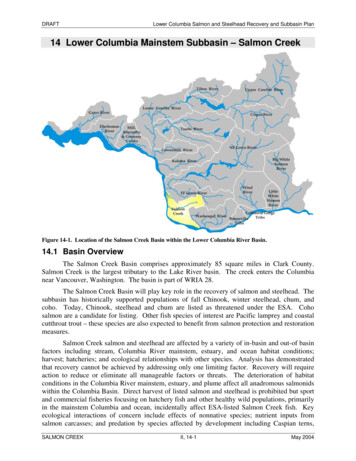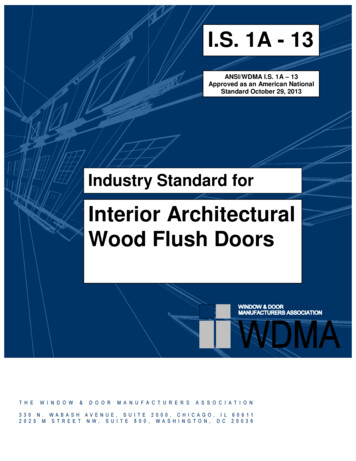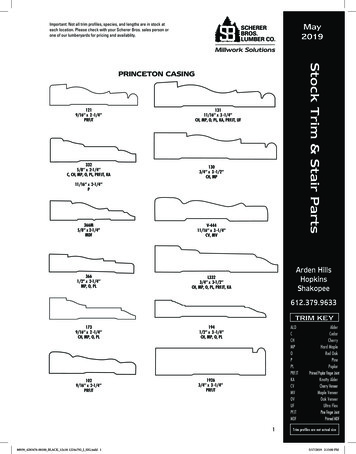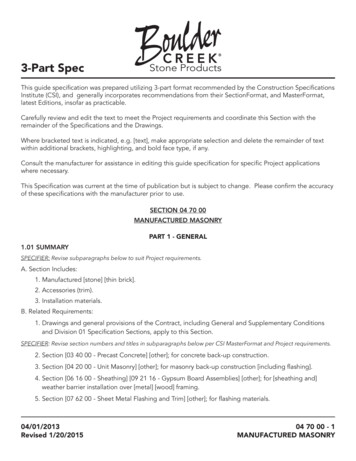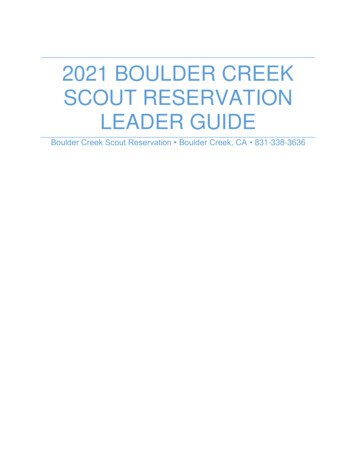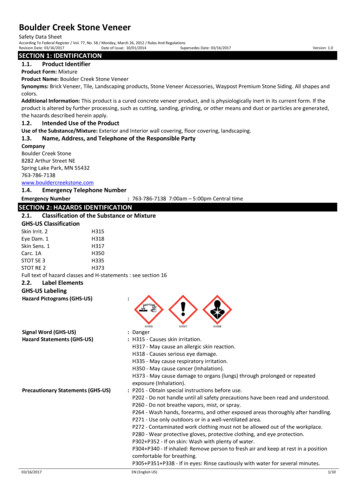
Transcription
Boulder Creek Stone VeneerSafety Data SheetAccording To Federal Register / Vol. 77, No. 58 / Monday, March 26, 2012 / Rules And RegulationsRevision Date: 03/16/2017Date of Issue: 10/01/2014Supersedes Date: 03/16/2017SECTION 1: IDENTIFICATION1.1.Product Identifier1.2.Intended Use of the Product1.3.Name, Address, and Telephone of the Responsible Party1.4.Emergency Telephone NumberVersion: 1.0Product Form: MixtureProduct Name: Boulder Creek Stone VeneerSynonyms: Brick Veneer, Tile, Landscaping products, Stone Veneer Accessories, Waypost Premium Stone Siding. All shapes andcolors.Additional Information: This product is a cured concrete veneer product, and is physiologically inert in its current form. If theproduct is altered by further processing, such as cutting, sanding, grinding, or other means and dust or particles are generated,the hazards described herein apply.Use of the Substance/Mixture: Exterior and Interior wall covering, floor covering, landscaping.CompanyBoulder Creek Stone8282 Arthur Street NESpring Lake Park, MN y Number: 763-786-7138 7:00am – 5:00pm Central timeSECTION 2: HAZARDS IDENTIFICATION2.1.Classification of the Substance or MixtureGHS-US ClassificationSkin Irrit. 2H315Eye Dam. 1H318Skin Sens. 1H317Carc. 1AH350STOT SE 3H335STOT RE 2H373Full text of hazard classes and H-statements : see section 162.2.Label ElementsGHS-US LabelingHazard Pictograms (GHS-US):Signal Word (GHS-US)Hazard Statements (GHS-US): Danger: H315 - Causes skin irritation.H317 - May cause an allergic skin reaction.H318 - Causes serious eye damage.H335 - May cause respiratory irritation.H350 - May cause cancer (Inhalation).H373 - May cause damage to organs (lungs) through prolonged or repeatedexposure (Inhalation).: P201 - Obtain special instructions before use.P202 - Do not handle until all safety precautions have been read and understood.P260 - Do not breathe vapors, mist, or spray.P264 - Wash hands, forearms, and other exposed areas thoroughly after handling.P271 - Use only outdoors or in a well-ventilated area.P272 - Contaminated work clothing must not be allowed out of the workplace.P280 - Wear protective gloves, protective clothing, and eye protection.P302 P352 - If on skin: Wash with plenty of water.P304 P340 - If inhaled: Remove person to fresh air and keep at rest in a positioncomfortable for breathing.P305 P351 P338 - If in eyes: Rinse cautiously with water for several minutes.Precautionary Statements (GHS-US)03/16/2017GHS05EN (English US)GHS07GHS081/10
Boulder Creek Stone VeneerSafety Data SheetAccording to Federal Register / Vol. 77, No. 58 / Monday, March 26, 2012 / Rules and RegulationsRemove contact lenses, if present and easy to do. Continue rinsing.P308 310 313 - If exposed or concerned: Get medical advice/attention.Immediately call a poison center or doctor.P314 - Get medical advice/attention if you feel unwell.P321 - Specific treatment (see section 4 on this SDS).P333 P313 - If skin irritation or rash occurs: Get medical advice/attention.P362 P364 - Take off contaminated clothing and wash it before reuse.P403 P233 - Store in a well-ventilated place. Keep container tightly closed.P405 - Store locked up.P501 - Dispose of contents/container in accordance with local, regional, national,and international regulations.2.3.Other Hazards2.4.Unknown Acute Toxicity (GHS-US)This product is physiologically inert in its current form. If the product is altered by processing, cutting, sanding, or other means anddust or particles are generated, the hazards described herein apply. May cause mechanical abrasion/irritation. Exposure mayaggravate pre-existing eye, skin, or respiratory conditions. This product may contain trace amounts of hexavalent chromium andnickel.No data availableSECTION 3: COMPOSITION/INFORMATION ON INGREDIENTS3.1.Substance3.2.MixtureNot applicableNameShale, expanded, aggregates*Product Identifier(CAS No) 68334-37-2%54.66Cement, portland, chemicals(CAS No) 65997-15-124.64WaterAshes, residues(CAS No) 7732-18-5(CAS No) 68131-74-8Quartz(CAS No) 14808-60-713.664.319 5.8615 0.617Calcium chlorideCalcium oxide(CAS No) 10043-52-4(CAS No) 1305-78-80.46 0.1851Manganese oxide (MnO2)(CAS No) 1313-13-9 0.1234Phosphorus oxide (P2O5)(CAS No) 1314-56-3 0.1234Potassium oxide(CAS No) 12136-45-7 0.1234Magnesium sulfate(CAS No) 7487-88-9 0.123403/16/2017EN (English US)GHS-US classificationCarc. 1A, H350STOT SE 3, H335STOT RE 2, H373Skin Irrit. 2, H315Eye Dam. 1, H318Skin Sens. 1, H317STOT SE 3, H335Not classifiedEye Irrit. 2B, H320Carc. 1A, H350STOT SE 3, H335STOT RE 1, H372Eye Irrit. 2A, H319Skin Irrit. 2, H315Eye Dam. 1, H318STOT SE 3, H335Aquatic Acute 3, H402Acute Tox. 4 (Oral), H302Acute Tox. 4 (Inhalation),H332STOT RE 2, H373Skin Corr. 1A, H314Eye Dam. 1, H318Skin Corr. 1A, H314Eye Dam. 1, H318Not classified2/10
Boulder Creek Stone VeneerSafety Data SheetAccording to Federal Register / Vol. 77, No. 58 / Monday, March 26, 2012 / Rules and RegulationsSodium hydroxide(CAS No) 1310-73-20.00008Met. Corr. 1, H290Skin Corr. 1A, H314Eye Dam. 1, H318Aquatic Acute 3, H402Full text of H-phrases: see section 16*Product is a UVCB and may contain Quartz.SECTION 4: FIRST AID MEASURES4.1.Description of First-aid Measures4.2.Most Important Symptoms and Effects Both Acute and Delayed4.3.Indication of Any Immediate Medical Attention and Special Treatment NeededFirst-aid Measures General: Never give anything by mouth to an unconscious person. If you feel unwell, seek medical advice(show the label where possible).First-aid Measures After Inhalation: For particulates and dust: Encourage exposed person to cough, spit out, and blow nose toremove dust. When symptoms occur: go into open air and ventilate suspected area. Obtain medical attention if breathingdifficulty persists.First-aid Measures After Skin Contact: For particulates and dust: Remove contaminated clothing. Drench affected area withwater for at least 15 minutes. Obtain medical attention if irritation develops or persists.First-aid Measures After Eye Contact: Rinse cautiously with water for at least 60 minutes. Remove contact lenses, if present andeasy to do. Continue rinsing. Get immediate medical advice/attention.First-aid Measures After Ingestion: Rinse mouth. Do NOT induce vomiting. Obtain medical attention.Symptoms/Injuries: Causes skin irritation. Causes serious eye damage. May cause respiratory irritation. Skin sensitization. Maycause cancer. May cause damage to organs through prolonged or repeated exposure.Symptoms/Injuries After Inhalation: For particulates and dust: Irritation of the respiratory tract and the other mucousmembranes. Repeated or prolonged exposure to respirable (airborne) crystalline silica dust will cause lung damage in the form ofsilicosis. Symptoms will include progressively more difficult breathing, cough, fever, and weight loss.Symptoms/Injuries After Skin Contact: For particulates and dust: Redness, pain, swelling, itching, burning, dryness, anddermatitis. May cause an allergic skin reaction. Aggregates may cause dry skin, abrasions, discomfort, and irritation. This productcontains portland cement: Cement clinker and cement may cause dry skin, discomfort, irritation, severe burns, and dermatitis. Askin exposure may be hazardous even if there is no pain or discomfort. Dermatitis: Cement and clinker dust are capable ofcausing dermatitis by irritation and allergy. Skin affected by dermatitis may include symptoms such as, redness, itching, rash,scaling, and cracking. Irritant dermatitis is caused by the physical properties of clinker dust and cement including alkalinity andabrasion. Allergic contact dermatitis is caused by sensitization to hexavalent chromium (chromate) present in cement. Thereaction can range from a mild rash to severe skin ulcers. Persons already sensitized may react to the first contact with cement.Others may develop allergic dermatitis after years of repeated contact with clinker dust or cement.Symptoms/Injuries After Eye Contact: For particulates and dust: Causes permanent damage to the cornea, iris, or conjunctiva.Symptoms/Injuries After Ingestion: Ingestion may cause adverse effects.Chronic Symptoms: For particulates and dust: May cause cancer by inhalation. May cause damage to organs (lungs) throughprolonged or repeated exposure (inhalation). Dry sawing or grinding of concrete masonry products may result in the release ofrespirable crystalline quartz. Prolonged exposure to respirable crystalline quartz may cause delayed (chronic) lung injury(silicosis). Acute or rapidly developing silicosis may occur in a short period of time in heavy exposure. Silicosis is a form ofdisabling pulmonary fibrosis which can be progressive and may lead to death.If exposed or concerned, get medical advice and attention. If medical advice is needed, have product container or label at hand.SECTION 5: FIRE-FIGHTING MEASURES5.1.Extinguishing Media5.2.Special Hazards Arising From the Substance or Mixture5.3.Advice for FirefightersSuitable Extinguishing Media: Use extinguishing media appropriate for surrounding fire. Water spray, dry chemical, foam,carbon dioxide.Unsuitable Extinguishing Media: Do not use a heavy water stream. Use of heavy stream of water may spread fire.Fire Hazard: Not considered flammable but may burn at high temperatures.Explosion Hazard: Product is not explosive.Reactivity: Hazardous reactions will not occur under normal conditions. Aggregate dissolves in hydrofluoric acid, producingcorrosive silicon tetrafluoride gas. Silicates react with powerful oxidizers such as fluorine, boron trifluoride, chlorine trifluoride,manganese trifluoride, and oxygen difluoride.Precautionary Measures Fire: Exercise caution when fighting any chemical fire.03/16/2017EN (English US)3/10
Boulder Creek Stone VeneerSafety Data SheetAccording to Federal Register / Vol. 77, No. 58 / Monday, March 26, 2012 / Rules and RegulationsFirefighting Instructions: Use water spray or fog for cooling exposed containers. Do not breathe fumes from fires or vapors fromdecomposition. Avoid raising dust.Protection During Firefighting: Do not enter fire area without proper protective equipment, including respiratory protection.Hazardous Combustion Products: Thermal decomposition generates: Carbon oxides (CO, CO2). Silica compounds. calcium oxide.Oxides of manganese. Phosphorus oxides. Oxides of magnesium. Potassium oxides. Crystalline silica exists in several forms, themost common of which is quartz. If crystalline silica (quartz) is heated to more than 870 C, it can change to a form of crystallinesilica known as trydimite, and if crystalline silica (quartz) is heated to more than 1470 C, it can change to a form of crystallinesilica known as cristobalite. The OSHA PEL for crystalline silica as trydimite and cristobalite is one-half of the OSHA PEL forcrystalline silica (quartz).SECTION 6: ACCIDENTAL RELEASE MEASURES6.1.Personal Precautions, Protective Equipment and Emergency ProceduresGeneral Measures: Avoid generating dust. Do not breathe dust. Do not get in eyes, on skin, or on clothing. Do not handle untilall safety precautions have been read and understood.6.1.1.For Non-Emergency Personnel6.1.2.For Emergency PersonnelProtective Equipment: Use appropriate personal protective equipment (PPE).Emergency Procedures: Evacuate unnecessary personnel.Protective Equipment: Equip cleanup crew with proper protection.Emergency Procedures: Ventilate area. Upon arrival at the scene, a first responder is expected to recognize the presence ofdangerous goods, protect oneself and the public, secure the area, and call for the assistance of trained personnel as soon asconditions permit.6.2.Environmental Precautions6.3.Methods and Materials for Containment and Cleaning Up6.4.Reference to Other SectionsPrevent entry to sewers and public waters.For Containment: Contain solid spills with appropriate barriers and prevent migration and entry into sewers or streams.Methods for Cleaning Up: Clean up spills immediately and dispose of waste safely. Avoid generation of dust during clean-up ofspills. Recover the product by vacuuming, shoveling or sweeping. Vacuum clean-up is preferred. If sweeping is required use adust suppressant. Transfer spilled material to a suitable container for disposal. Contact competent authorities after a spill.See Section 8 for exposure controls and personal protection and Section 13 for disposal considerations.SECTION 7: HANDLING AND STORAGE7.1.Precautions for Safe Handling7.2.Conditions for Safe Storage, Including Any Incompatibilities7.3.Specific End Use(s)Additional Hazards When Processed: As supplied in its massive form, this product is inert. Cutting, crushing or grindingcrystalline silica-bearing materials will release respirable crystalline silica. Use all appropriate measures of dust control orsuppression, and Personal Protective Equipment (PPE) described in Section 8 below. Do not handle until all safety precautionshave been read and understood. Repeated or prolonged exposure to respirable (airborne) crystalline silica dust will cause lungdamage in the form of silicosis. Symptoms will include progressively more difficult breathing, cough, fever, and weight loss.Precautions for Safe Handling: Obtain special instructions before use. Do not handle until all safety precautions have been readand understood. Wash hands and other exposed areas with mild soap and water before eating, drinking or smoking and whenleaving work. Do not get in eyes, on skin, or on clothing. Do not breathe dust. Use appropriate personal protective equipment(PPE).Hygiene Measures: Handle in accordance with good industrial hygiene and safety procedures.Technical Measures: Comply with applicable regulations.Storage Conditions: Keep container closed when not in use. Store in a dry, cool and well-ventilated place. Keep/Store away fromdirect sunlight, extremely high or low temperatures and incompatible materials.Incompatible Products: Strong acids, strong bases, strong oxidizers. Hydrofluoric acid. Ammonium salts. Aggregate dissolves inhydrofluoric acid, producing corrosive silicon tetrafluoride gas. Silicates react with powerful oxidizers such as fluorine, borontrifluoride, chlorine trifluoride, manganese trifluoride, and oxygen difluoride.Exterior and Interior wall covering, floor covering, landscapingSECTION 8: EXPOSURE CONTROLS/PERSONAL PROTECTION8.1.Control ParametersFor substances listed in section 3 that are not listed here, there are no established exposure limits from the manufacturer,supplier, importer, or the appropriate advisory agency including: ACGIH (TLV), AIHA (WEEL), NIOSH (REL), or OSHA (PEL).03/16/2017EN (English US)4/10
Boulder Creek Stone VeneerSafety Data SheetAccording to Federal Register / Vol. 77, No. 58 / Monday, March 26, 2012 / Rules and RegulationsCement, portland, chemicals (65997-15-1)USA ACGIH ACGIH TWA (mg/m³)USA ACGIHUSA NIOSHACGIH chemical categoryNIOSH REL (TWA) (mg/m³)USA IDLHUSA OSHAUS IDLH (mg/m³)OSHA PEL (TWA) (mg/m³)1 mg/m³ (particulate matter containing no asbestos and 1%crystalline silica, respirable particulate matter)Not Classifiable as a Human Carcinogen10 mg/m³ (total dust)5 mg/m³ (respirable dust)5000 mg/m³15 mg/m³ (total dust)5 mg/m³ (respirable fraction)Quartz (14808-60-7)USA ACGIH ACGIH TWA (mg/m³)0.025 mg/m³ (respirable particulate matter)USA ACGIH ACGIH chemical categoryA2 - Suspected Human CarcinogenUSA NIOSH NIOSH REL (TWA) (mg/m³)0.05 mg/m³ (respirable dust)USA IDLHUS IDLH (mg/m³)50 mg/m³ (respirable dust)USA OSHAOSHA PEL (TWA) (mg/m³)50 µg/m³Calcium oxide (1305-78-8)USA ACGIH ACGIH TWA (mg/m³)2 mg/m³USA NIOSH NIOSH REL (TWA) (mg/m³)2 mg/m³USA IDLHUS IDLH (mg/m³)25 mg/m³USA OSHAOSHA PEL (TWA) (mg/m³)5 mg/m³Sodium hydroxide (1310-73-2)USA ACGIH ACGIH Ceiling (mg/m³)2 mg/m³USA NIOSH NIOSH REL (ceiling) (mg/m³)2 mg/m³USA IDLHUS IDLH (mg/m³)10 mg/m³USA OSHAOSHA PEL (TWA) (mg/m³)2 mg/m³Particulates not otherwise classified (PNOC) (Not applicable)USA ACGIH ACGIH TWA (mg/m³)3 mg/m3 Respirable fraction10 mg/m3 Total DustUSA OSHAOSHA PEL (TWA) (mg/m³)5 mg/m3 Respirable fraction15 mg/m3 Total Dust8.2.Exposure ControlsAppropriate Engineering ControlsPersonal Protective EquipmentMaterials for Protective ClothingHand ProtectionEye ProtectionSkin and Body ProtectionRespiratory ProtectionOther Information: Emergency eye wash fountains and safety showers should be available in theimmediate vicinity of any potential exposure. Ensure adequate ventilation,especially in confined areas. Avoid creating or spreading dust. Ensure allnational/local regulations are observed.: Gloves. Protective clothing. Protective goggles. Insufficient ventilation: wearrespiratory protection.:::::Chemically resistant materials and fabrics.Wear protective gloves.In case of excessive dust production, safety goggles are recommended.Wear suitable protective clothing.The following applies to the product if it is cut, sanded or altered in such a way thatexcessive and/or significant particulates and/or dusts may be generated: Ifexposure limits are exceeded or irritation is experienced, approved respiratoryprotection should be worn. In case of inadequate ventilation, oxygen deficientatmosphere, or where exposure levels are not known wear approved respiratoryprotection.: When using, do not eat, drink or smoke.SECTION 9: PHYSICAL AND CHEMICAL PROPERTIES9.1.Information on Basic Physical and Chemical PropertiesPhysical State03/16/2017: SolidEN (English US)5/10
Boulder Creek Stone VeneerSafety Data SheetAccording to Federal Register / Vol. 77, No. 58 / Monday, March 26, 2012 / Rules and RegulationsAppearance: Varied colored concreteOdor: No data availableOdor Threshold: No data availablepH: No data availableEvaporation Rate: No data availableMelting Point: No data availableFreezing Point: No data availableBoiling Point: No data availableFlash Point: No data availableAuto-ignition Temperature: No data availableDecomposition Temperature: No data availableFlammability (solid, gas): No data availableVapor Pressure: No data availableRelative Vapor Density at 20 C: No data availableRelative Density: No data availableSolubility: No data availablePartition Coefficient: N-Octanol/Water: No data availableViscosity: No data available9.2.Other Information No additional information availableSECTION 10: STABILITY AND REACTIVITY10.1.Reactivity: Hazardous reactions will not occur under normal conditions. Aggregate dissolves in hydrofluoric acid,producing corrosive silicon tetrafluoride gas. Silicates react with powerful oxidizers such as fluorine, boron trifluoride, chlorinetrifluoride, manganese trifluoride, and oxygen difluoride.10.2.Chemical Stability: Stable under recommended handling and storage conditions (see section 7).10.3.Possibility of Hazardous Reactions: Hazardous polymerization will not occur.10.4.Conditions to Avoid: Incompatible materials. Avoid creating or spreading dust.10.5.Incompatible Materials: Strong acids, strong bases, strong oxidizers. Hydrofluoric acid. Ammonium salts. Aggregatedissolves in hydrofluoric acid, producing corrosive silicon tetrafluoride gas. Silicates react with powerful oxidizers such as fluorine,boron trifluoride, chlorine trifluoride, manganese trifluoride, and oxygen difluoride.10.6.Hazardous Decomposition Products: Under normal conditions of storage and use, hazardous decomposition productsshould not be produced.SECTION 11: TOXICOLOGICAL INFORMATION11.1.Information on Toxicological EffectsAcute Toxicity: Not classifiedAshes, residues (68131-74-8)LD50 Oral RatQuartz (14808-60-7)LD50 Oral RatLD50 Dermal RatCalcium oxide (1305-78-8)LD50 Oral RatLD50 Dermal RabbitManganese oxide (MnO2) (1313-13-9)LD50 Oral RatATE (Oral)ATE (Gases)ATE (Vapors)ATE (Dust/Mist)Phosphorus oxide (P2O5) (1314-56-3)LC50 Inhalation RatMagnesium sulfate (7487-88-9)LD50 Oral Rat03/16/2017 2000 mg/kg 5000 mg/kg 5000 mg/kg 2000 mg/kg 2500 mg/kg9000 mg/kg500.00 mg/kg body weight4,500.00 ppmV/4h11.00 mg/l/4h1.50 mg/l/4h1217 mg/m³ (Exposure time: 1 h) 2000 mg/kgEN (English US)6/10
Boulder Creek Stone VeneerSafety Data SheetAccording to Federal Register / Vol. 77, No. 58 / Monday, March 26, 2012 / Rules and RegulationsCalcium chloride (10043-52-4)LD50 Oral Rat2301 (1455 - 2781) mg/kgLD50 Dermal Rabbit 5000 mg/kgSodium hydroxide (1310-73-2)LD50 Dermal Rabbit1350 mg/kgSkin Corrosion/Irritation: Causes skin irritation.Serious Eye Damage/Irritation: Causes serious eye damage.Respiratory or Skin Sensitization: May cause an allergic skin reaction.Germ Cell Mutagenicity: Not classifiedCarcinogenicity: May cause cancer (Inhalation).Quartz (14808-60-7)IARC group1National Toxicology Program (NTP) StatusKnown Human Carcinogens.OSHA Hazard Communication Carcinogen ListIn OSHA Hazard Communication Carcinogen list.Reproductive Toxicity: Not classifiedSpecific Target Organ Toxicity (Single Exposure): May cause respiratory irritation.Specific Target Organ Toxicity (Repeated Exposure): May cause damage to organs (lungs) through prolonged or repeatedexposure (Inhalation).Aspiration Hazard: Not classifiedSymptoms/Injuries After Inhalation: For particulates and dust: Irritation of the respiratory tract and the other mucousmembranes. Repeated or prolonged exposure to respirable (airborne) crystalline silica dust will cause lung damage in the form ofsilicosis. Symptoms will include progressively more difficult breathing, cough, fever, and weight loss.Symptoms/Injuries After Skin Contact: For particulates and dust: Redness, pain, swelling, itching, burning, dryness, anddermatitis. May cause an allergic skin reaction. Aggregates may cause dry skin, abrasions, discomfort, and irritation. This productcontains portland cement: Cement clinker and cement may cause dry skin, discomfort, irritation, severe burns, and dermatitis. Askin exposure may be hazardous even if there is no pain or discomfort. Dermatitis: Cement and clinker dust are capable ofcausing dermatitis by irritation and allergy. Skin affected by dermatitis may include symptoms such as, redness, itching, rash,scaling, and cracking. Irritant dermatitis is caused by the physical properties of clinker dust and cement including alkalinity andabrasion. Allergic contact dermatitis is caused by sensitization to hexavalent chromium (chromate) present in cement. Thereaction can range from a mild rash to severe skin ulcers. Persons already sensitized may react to the first contact with cement.Others may develop allergic dermatitis after years of repeated contact with clinker dust or cement.Symptoms/Injuries After Eye Contact: For particulates and dust: Causes permanent damage to the cornea, iris, or conjunctiva.Symptoms/Injuries After Ingestion: Ingestion may cause adverse effects.Chronic Symptoms: For particulates and dust: May cause cancer by inhalation. May cause damage to organs (lungs) throughprolonged or repeated exposure (inhalation). Dry sawing or grinding of concrete masonry products may result in the release ofrespirable crystalline quartz. Prolonged exposure to respirable crystalline quartz may cause delayed (chronic) lung injury(silicosis). Acute or rapidly developing silicosis may occur in a short period of time in heavy exposure. Silicosis is a form ofdisabling pulmonary fibrosis which can be progressive and may lead to death.SECTION 12: ECOLOGICAL INFORMATION12.1.ToxicityEcology - GeneralCalcium oxide (1305-78-8)LC50 Fish 1Magnesium sulfate (7487-88-9)LC50 Fish 1EC50 Daphnia 1Calcium chloride (10043-52-4)LC50 Fish 1EC50 Daphnia 1Sodium hydroxide (1310-73-2)LC50 Fish 1EC50 Daphnia 112.2.Persistence and Degradability: Not classified.50.6 mg/l2610 - 3080 mg/l (Exposure time: 96 h - Species: Pimephales promelas [static])266.4 - 417.3 mg/l (Exposure time: 48 h - Species: Daphnia magna [Static])10650 mg/l (Exposure time: 96 h - Species: Lepomis macrochirus [static])2400 mg/l (Exposure time: 48 h - Species: Daphnia magna)45.4 mg/l (Exposure time: 96 h - Species: Oncorhynchus mykiss [static])40 mg/lBoulder Creek Stone Veneer03/16/2017EN (English US)7/10
Boulder Creek Stone VeneerSafety Data SheetAccording to Federal Register / Vol. 77, No. 58 / Monday, March 26, 2012 / Rules and RegulationsPersistence and Degradability12.3.Bioaccumulative Potential12.5.Other Adverse EffectsNot established.Boulder Creek Stone VeneerBioaccumulative PotentialNot established.Calcium oxide (1305-78-8)BCF Fish 1(no bioaccumulation)Manganese oxide (MnO2) (1313-13-9)BCF Fish 1(no bioaccumulation expected)Log Pow 0 (at 20 C)Calcium chloride (10043-52-4)BCF Fish 1(no bioaccumulation)12.4.Mobility in Soil No additional information availableOther InformationSECTION 13: DISPOSAL CONSIDERATIONS13.1.: Avoid release to the environment.Waste Treatment MethodsWaste Disposal Recommendations: Dispose of contents/container in accordance with local, regional, national, and internationalregulations.Additional Information: Container may remain hazardous when empty. Continue to observe all precautions.Ecology - Waste Materials: Avoid release to the environment.SECTION 14: TRANSPORT INFORMATIONThe shipping description(s) stated herein were prepared in accordance with certain assumptions at the time the SDS wasauthored, and can vary based on a number of variables that may or may not have been known at the time the SDS was issued.14.1.In Accordance with DOT Not regulated for transport14.2.In Accordance with IMDG Not regulated for transport14.3.In Accordance with IATA Not regulated for transportSECTION 15: REGULATORY INFORMATION15.1.US Federal RegulationsBoulder Creek Stone VeneerSARA Section 311/312 Hazard ClassesImmediate (acute) health hazardDelayed (chronic) health hazardShale, expanded, aggregates (68334-37-2)Listed on the United States TSCA (Toxic Substances Control Act) inventoryCement, portland, chemicals (65997-15-1)Listed on the United States TSCA (Toxic Substances Control Act) inventoryAshes, residues (68131-74-8)Listed on the United States TSCA (Toxic Substances Control Act) inventoryQuartz (14808-60-7)Listed on the United States TSCA (Toxic Substances Control Act) inventoryCalcium oxide (1305-78-8)Listed on the United States TSCA (Toxic Substances Control Act) inventoryManganese oxide (MnO2) (1313-13-9)Listed on the United States TSCA (Toxic Substances Control Act) inventoryPhosphorus oxide (P2O5) (1314-56-3)Listed on the United States TSCA (Toxic Substances Control Act) inventoryPotassium oxide (12136-45-7)Listed on the United States TSCA (Toxic Substances Control Act) inventoryMagnesium sulfate (7487-88-9)Listed on the United States TSCA (Toxic Substances Control Act) inventoryWater (7732-18-5)Listed on the United States TSCA (Toxic Substances Control Act) inventoryCalcium chloride (10043-52-4)03/16/2017EN (English US)8/10
Boulder Creek Stone VeneerSafety Data SheetAccording to Federal Register / Vol. 77, No. 58 / Monday, March 26, 2012 / Rules and RegulationsListed on the United States TSCA (Toxic Substances Control Act) inventorySodium hydroxide (1310-73-2)Listed on the United States TSCA (Toxic Substances Control Act) inventoryCERCLA RQ1000 lb15.2.US State RegulationsCement, portland, chemicals (65997-15-1)U.S. - Massachusetts - Right To Know ListU.S. - New Jersey - Right to Know Hazardous Substance ListU.S. - Pennsylvania - RTK (Right to Know) ListQuartz (14808-60-7)U.S. - Massachusetts - Right To Know ListU.S. - New Jersey - Right to Know Hazardous Substance ListU.S. - Pennsylvania - RTK (Right to Know) ListCalcium oxide (1305-78-8)U.S. - Massachusetts - Right To Know ListU.S. - New Jersey - Right to Know Hazardous Substance ListU.S. - Pennsylvania - RTK (Right to Know) ListPhosphorus oxide (P2O5) (1314-56-3)U.S. - Massachusetts - Right To Know ListU.S. - New Jersey - Right to Know Hazardous Substance ListU.S. - Pennsylvania - RTK (Right to Know) - Environmental Hazard ListU.S. - Pennsylvania - RTK (Right to Know) ListPotassium oxide (12136-45-7)U.S. - New Jersey - Right to Know Hazardous Substance ListSodium hydroxide (1310-73-2)U.S. - Massachusetts - Right To Know ListU.S. - New Jersey - Right to Know Hazardous Substance ListU.S. - Pennsylvania - RTK (Right to Know) - Environmental Hazard ListU.S. - Pennsylvania - RTK (Right to Know) ListSECTION 16: OTHER INFORMATION, INCLUDING DATE OF PREPARATION OR LAST REVISIONRevision DateOther Information: 03/16/2017: This document has been prepared in accordance with the SDSrequirements of the OSHA Hazard Communication Standard 29 CFR1910.1200GHS Full Text Phrases:------ Acute Tox. 4 (Inhalation)------ Acute Tox. 4 (Oral)------ Aquatic Acute 3------ Carc. 1A------ Eye Dam. 1------ Eye Irrit. 2A------ Eye Irrit. 2B------ Met. Corr. 1------ Skin Corr. 1A------ Skin Irrit. 2------ Skin Sens. 1------ STOT RE 1------ STOT RE 2------ STOT SE 3------ H290------ H302------ H31403/16/2017Acute toxicity (inhalation) Category 4Acute toxicity (oral) Category 4Hazardous to the aquatic environment - Acute Hazard Category 3Carcinogenicity Category 1ASerious eye damage/eye irritation Category 1Serious eye damage/eye irritation Category 2ASerious eye damage/eye irritation Category 2BCorrosive to metals Category 1Skin corrosion/irritation Category 1ASkin corrosion/irritation Category 2Skin sensitization Category 1Specific target organ toxicity (repeated exposure) Category 1Specific target organ toxicity (repeated exposure) Category 2Specific target organ toxicity (single exposure) Category 3May be corrosive to metalsHarmful if swallowedCauses severe skin burns and eye damageEN (English US)9/10
Boulder Creek Stone VeneerSafety Data SheetAccording to Federal Register / Vol. 77, No. 58 / Monday, March 26, 2012 / Rules and 372H373H402Causes skin irritationMay cause an allergic skin reactionCauses serious eye damageCauses serious eye irritationCauses eye irritationHarmful if inhaledMay cause respiratory irritationMay cause cancerCauses damage to organs through prolonged or repeated exposureMay
Boulder Creek Stone 8282 Arthur Street NE Spring Lake Park, MN 55432 763-786-7138 www.bouldercreekstone.com 1.4. Emergency Telephone Number Emergency Number: 763 -786 7138 7:00am - 5:00pm Central time SECTION 2: HAZARDS IDENTIFICATION. 2.1. Classification of the Substance or Mixture . GHS-US Classification . Skin Irrit. 2 H315 Eye Dam. 1 H318





